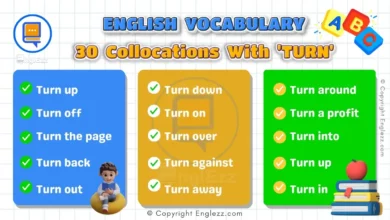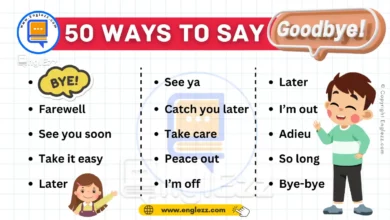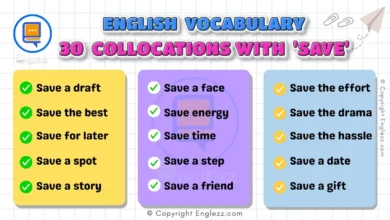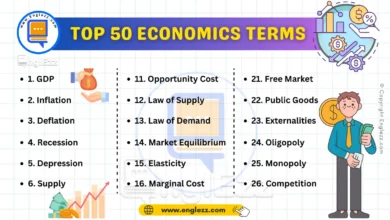In today’s fast-paced world, understanding technology-related terminology is crucial for students. From programming to digital media, technology terms are integral to navigating both academic and professional landscapes. This guide covers 50 essential technology English terms, providing clear definitions, phonetic transcriptions, and practical examples.
Table of Contents
- 50 Essential Technology English Terms with Definitions & Examples
- #1. Algorithm 🤖
- #2. Bandwidth 🌐
- #3. Bug 🐛
- #4. Cloud Computing ☁️
- #5. Cybersecurity 🔐
- #6. Data Encryption 🔒
- #7. Firewall 🛡️
- #8. HTML 📜
- #9. IP Address 🌍
- #10. JavaScript 💻
- #11. Machine Learning 🤖
- #12. Network Topology 🌐
- #13. Operating System 💾
- #14. Protocol 📡
- #15. Query 🔍
- #16. Server 🖥️
- #17. Software 🛠️
- #18. URL 🌐
- #19. Virtual Reality 🌟
- #20. Wireless Network 📶
- #21. XML 📜
- #22. Encryption 🔐
- #23. API 🌐
- #24. Blockchain ⛓️
- #25. Cache 🗄️
- #26. Cloud Storage ☁️
- #27. Data Mining 🔍
- #28. Debugging 🛠️
- #29. Encryption 🔐
- #30. Front-End Development 🌐
- #31. IoT (Internet of Things) 🌍
- #32. Java 🟨
- #33. Machine Vision 🤖
- #34. Node 🌐
- #35. Open Source 🔓
- #36. Protocol 📡
- #37. Query Language 📚
- #38. SaaS (Software as a Service) 💻
- #39. Scalability 📈
- #40. Server-Side Scripting 💾
- #41. UI/UX Design 🎨
- #42. VPN (Virtual Private Network) 🔒
- #43. Web Hosting 🌐
- #44. XML (eXtensible Markup Language) 📜
- #45. Big Data 📊
- #46. Data Analytics 📈
- #47. Front-End Framework 🔧
- #48. Backend Development 💻
- #49. DevOps 🤝
- #50. Quantum Computing 💻
- 50 Technology English Terms Table
- Conclusion
50 Essential Technology English Terms with Definitions & Examples
Whether you’re a computer science student or just curious about the tech world, familiarizing yourself with these terms will enhance your comprehension and communication skills.
By mastering these terms, you’ll be better equipped to engage in discussions, solve problems, and stay ahead in your field.
#1. Algorithm 🤖
Definition: A step-by-step procedure for solving a problem or completing a task.
Phonetic Transcription: ˈælɡəˌrɪðəm
Examples:
- A recipe for baking a cake is an example of a simple algorithm.
- Search engines use complex algorithms to rank web pages.
#2. Bandwidth 🌐
Definition: The maximum rate of data transfer across a network.
Phonetic Transcription: ˈbændˌwɪdθ
Examples:
- Streaming a movie in high definition requires higher bandwidth.
- Businesses often upgrade their internet bandwidth to support more users.
#3. Bug 🐛
Definition: An error or flaw in a software program that causes it to behave unexpectedly.
Phonetic Transcription: bʌɡ
Examples:
- The application crashed due to a bug in the code.
- Developers spend a lot of time debugging their programs.
#4. Cloud Computing ☁️
Definition: The delivery of computing services over the internet, including storage, processing, and applications.
Phonetic Transcription: klaʊd kəmˈpjuːtɪŋ
Examples:
- Storing photos on Google Drive is an example of cloud computing.
- Many companies use cloud computing to run their email services.
#5. Cybersecurity 🔐
Definition: The practice of protecting systems, networks, and data from digital attacks.
Phonetic Transcription: ˌsaɪbərsɪˈkjʊərɪti
Examples:
- Implementing firewalls and encryption is essential for cybersecurity.
- Regularly updating software helps prevent cybersecurity breaches.
#6. Data Encryption 🔒
Definition: The process of converting data into a code to prevent unauthorized access.
Phonetic Transcription: ˈdeɪtə ɪnˈkrɪpʃən
Examples:
- Banking apps use data encryption to protect user information.
- Email services often offer encryption options for secure communication.
#7. Firewall 🛡️
Definition: A network security system that monitors and controls incoming and outgoing traffic.
Phonetic Transcription: ˈfaɪərwɔːl
Examples:
- A firewall helps protect your computer from malicious attacks.
- Companies use firewalls to safeguard their internal networks.
#8. HTML 📜
Definition: Hypertext Markup Language; the standard language for creating web pages.
Phonetic Transcription: ˈeɪtʃˌtiːˈɛmˈɛl
Examples:
- HTML is used to structure content on a web page.
- Web developers use HTML tags to format text and images.
#9. IP Address 🌍
Definition: A unique string of numbers assigned to each device connected to a network.
Phonetic Transcription: ˌaɪˈpiː əˈdrɛs
Examples:
- Your computer’s IP address identifies it on the internet.
- Websites track IP addresses to understand user demographics.
#10. JavaScript 💻
Definition: A programming language commonly used to create interactive effects within web browsers.
Phonetic Transcription: ˈdʒɑːvəˌskrɪpt
Examples:
- JavaScript is used to add animations to web pages.
- Developers use JavaScript to validate form inputs on websites.
#11. Machine Learning 🤖
Definition: A branch of artificial intelligence that involves the development of algorithms that allow computers to learn from and make decisions based on data.
Phonetic Transcription: məˈʃiːn ˈlɜːrnɪŋ
Examples:
- Machine learning is used in recommendation systems like Netflix.
- Spam filters in email applications use machine learning to identify junk mail.
#12. Network Topology 🌐
Definition: The arrangement of different elements (links, nodes, etc.) in a computer network.
Phonetic Transcription: ˈnɛtwɜːrk tɒˈpɒlədʒi
Examples:
- A star topology connects all devices to a central hub.
- Network topology impacts the performance and scalability of a network.
#13. Operating System 💾
Definition: Software that manages computer hardware and software resources and provides common services for computer programs.
Phonetic Transcription: ˈɒpəreɪtɪŋ ˈsɪstəm
Examples:
- Windows and macOS are popular operating systems for personal computers.
- Smartphones use operating systems like iOS and Android.
#14. Protocol 📡
Definition: A set of rules governing the exchange or transmission of data between devices.
Phonetic Transcription: ˈprəʊtəkɒl
Examples:
- The HTTP protocol is used for transferring web pages.
- Email communication follows the SMTP protocol for sending messages.
#15. Query 🔍
Definition: A request for information from a database.
Phonetic Transcription: ˈkwɪəri
Examples:
- Searching for books in an online library involves a database query.
- SQL queries are used to retrieve specific data from relational databases.
#16. Server 🖥️
Definition: A computer or program that provides services to other computers or programs over a network.
Phonetic Transcription: ˈsɜːrvər
Examples:
- Web servers host websites and deliver web pages to users.
- Email servers handle the sending and receiving of emails.
#17. Software 🛠️
Definition: Programs and operating information used by a computer.
Phonetic Transcription: ˈsɒftwɛːr
Examples:
- Microsoft Word and Adobe Photoshop are examples of software applications.
- Software updates often include new features and security patches.
#18. URL 🌐
Definition: Uniform Resource Locator; the address used to access resources on the internet.
Phonetic Transcription: ˌjuː ɑːr ˈɛl
Examples:
- A URL directs you to a specific web page.
- URLs can include parameters to pass information to web applications.
#19. Virtual Reality 🌟
Definition: A simulated experience that can be similar to or completely different from the real world.
Phonetic Transcription: ˈvɜːrtʃuəl rɪˈælɪti
Examples:
- Virtual reality is used in gaming to create immersive experiences.
- VR simulations can be used for training in various industries.
#20. Wireless Network 📶
Definition: A network that uses radio signals instead of cables to connect devices.
Phonetic Transcription: ˈwaɪərləs ˈnɛtwɜːrk
Examples:
- Wi-Fi is a common wireless network used in homes and public places.
- Wireless networks enable mobile devices to connect to the internet without cables.
#21. XML 📜
Definition: Extensible Markup Language; a flexible text format used to create structured data.
Phonetic Transcription: ˌɛkˌsɛmˈɛl
Examples:
- XML is often used for data exchange between systems.
- RSS feeds use XML to format updates from blogs and news sites.
#22. Encryption 🔐
Definition: The process of encoding information to keep it secure.
Phonetic Transcription: ɪnˈkrɪpʃən
Examples:
- Encrypted messages are protected from unauthorized access.
- Many websites use encryption to secure user data during transactions.
#23. API 🌐
Definition: Application Programming Interface; a set of protocols for building and interacting with software applications.
Phonetic Transcription: ˌeɪ piː ˈaɪ
Examples:
- Social media platforms provide APIs for integrating their services with other apps.
- APIs are used to enable communication between different software systems.
#24. Blockchain ⛓️
Definition: A decentralized digital ledger that records transactions across many computers.
Phonetic Transcription: ˈblɒkˌtʃeɪn
Examples:
- Cryptocurrencies like Bitcoin use blockchain technology.
- Blockchain can be used for secure voting systems and supply chain management.
#25. Cache 🗄️
Definition: A hardware or software component that stores data to serve future requests more quickly.
Phonetic Transcription: kæʃ
Example:
- Web browsers use cache
#26. Cloud Storage ☁️
Definition: Online space used to store digital data and files on remote servers.
Phonetic Transcription: klaʊd ˈstɔːrɪdʒ
Examples:
- Google Drive and Dropbox are popular cloud storage services.
- Cloud storage allows users to access their files from any device with an internet connection.
#27. Data Mining 🔍
Definition: The process of analyzing large datasets to uncover hidden patterns or trends.
Phonetic Transcription: ˈdeɪtə ˈmaɪnɪŋ
Examples:
- Data mining helps businesses understand customer behavior and preferences.
- It is used in finance to detect fraudulent transactions.
#28. Debugging 🛠️
Definition: The process of identifying and fixing errors in software code.
Phonetic Transcription: dɪˈbʌɡɪŋ
Examples:
- Debugging tools help programmers find and resolve issues in their code.
- Regular debugging is crucial for maintaining software quality.
#29. Encryption 🔐
Definition: The process of converting data into a secure format that can only be read by authorized users.
Phonetic Transcription: ɪnˈkrɪpʃən
Examples:
- Encrypted communication ensures that messages are protected from eavesdropping.
- Online transactions often use encryption to secure payment information.
#30. Front-End Development 🌐
Definition: The part of web development that involves creating the user interface and user experience elements of a website.
Phonetic Transcription: frʌnt ɛnd dɪˈvɛləpmənt
Examples:
- Front-end developers use HTML, CSS, and JavaScript to build websites.
- Designing responsive layouts for different devices is a key aspect of front-end development.
#31. IoT (Internet of Things) 🌍
Definition: The network of interconnected devices that communicate and exchange data with each other over the internet.
Phonetic Transcription: aɪ oʊ tiː
Examples:
- Smart home devices like thermostats and lights are part of the IoT.
- Wearable fitness trackers collect and share data through IoT technology.
#32. Java 🟨
Definition: A high-level, class-based programming language used for building cross-platform applications.
Phonetic Transcription: ˈdʒɑːvə
Examples:
- Java is used to develop Android applications.
- Many large-scale enterprise systems are built using Java.
#33. Machine Vision 🤖
Definition: The technology that enables computers to interpret and process visual information from the world.
Phonetic Transcription: məˈʃiːn ˈvɪʒən
Examples:
- Machine vision is used in quality control for manufacturing processes.
- Autonomous vehicles use machine vision to navigate and detect obstacles.
#34. Node 🌐
Definition: A point of intersection or connection in a network.
Phonetic Transcription: noʊd
Examples:
- In a computer network, a node can be a computer or a router.
- Each device connected to a network acts as a node.
#35. Open Source 🔓
Definition: Software with source code that anyone can inspect, modify, and enhance.
Phonetic Transcription: ˈoʊpən sɔːrs
Examples:
- Linux is a popular open-source operating system.
- Many developers contribute to open-source projects to improve software collectively.
#36. Protocol 📡
Definition: A set of rules or procedures for transmitting data between electronic devices.
Phonetic Transcription: ˈprəʊtəkɒl
Examples:
- HTTP is a protocol used for transmitting web pages over the internet.
- FTP is used for transferring files between computers.
#37. Query Language 📚
Definition: A language used to make queries or requests for information from a database.
Phonetic Transcription: ˈkwɪəri ˈlæŋɡwɪdʒ
Examples:
- SQL is a common query language for managing relational databases.
- Query languages allow users to extract specific information from large datasets.
#38. SaaS (Software as a Service) 💻
Definition: A software delivery model where applications are hosted by a service provider and accessed over the internet.
Phonetic Transcription: sæz
Examples:
- Google Workspace and Microsoft 365 are examples of SaaS products.
- SaaS allows users to access software applications from any device with an internet connection.
#39. Scalability 📈
Definition: The capability of a system to handle a growing amount of work or its potential to accommodate growth.
Phonetic Transcription: ˌskeɪləˈbɪləti
Examples:
- Cloud services are designed to scale easily with increased demand.
- A scalable website can handle a surge in traffic without performance issues.
#40. Server-Side Scripting 💾
Definition: The process of running scripts on the server to generate dynamic web content before it is sent to the client.
Phonetic Transcription: ˈsɜːrvər saɪd ˈskrɪptɪŋ
Examples:
- PHP and ASP.NET are used for server-side scripting.
- Server-side scripts can be used to interact with databases and customize web pages.
#41. UI/UX Design 🎨
Definition: User Interface (UI) and User Experience (UX) design focus on creating intuitive and user-friendly interfaces and experiences.
Phonetic Transcription: ˌjuː ˌaɪ ˌjuː ˈɛks dɪˈzaɪn
Examples:
- UI/UX design ensures that apps are easy to use and navigate.
- Good UI/UX design improves overall user satisfaction with digital products.
#42. VPN (Virtual Private Network) 🔒
Definition: A technology that creates a secure, encrypted connection over a less secure network, such as the internet.
Phonetic Transcription: ˌviː piː ˈɛn
Examples:
- VPNs are used to protect privacy and security when browsing the internet.
- Employees use VPNs to securely access company resources from remote locations.
#43. Web Hosting 🌐
Definition: The service that allows individuals or organizations to post a website onto the internet.
Phonetic Transcription: wɛb ˈhoʊstɪŋ
Examples:
- Web hosting services provide server space for websites.
- Choosing a reliable web hosting provider is essential for website performance.
#44. XML (eXtensible Markup Language) 📜
Definition: A markup language that defines rules for encoding documents in a format that is both human-readable and machine-readable.
Phonetic Transcription: ˌɛkˌsɛmˈɛl
Examples:
- XML is often used for data interchange between systems.
- RSS feeds are formatted using XML to distribute updates from websites.
#45. Big Data 📊
Definition: Large and complex datasets that traditional data processing applications cannot handle efficiently.
Phonetic Transcription: bɪɡ ˈdeɪtə
Examples:
- Social media platforms generate big data from user interactions.
- Big data analytics help companies make informed business decisions.
#46. Data Analytics 📈
Definition: The science of analyzing raw data to make conclusions about that information.
Phonetic Transcription: ˈdeɪtə əˈnælɪtɪks
Examples:
- Data analytics is used to identify trends and patterns in sales data.
- Businesses use data analytics to understand customer behavior and preferences.
#47. Front-End Framework 🔧
Definition: A pre-written collection of code used to build the client-side of web applications more efficiently.
Phonetic Transcription: frʌnt ɛnd ˈfreɪmˌwɜːrk
Examples:
- Frameworks like React and Angular are popular front-end tools.
- They help developers create interactive user interfaces quickly.
#48. Backend Development 💻
Definition: The server-side of web development that involves working with databases, server logic, and application integration.
Phonetic Transcription: ˈbækˌɛnd dɪˈvɛləpmənt
Examples:
- Backend developers build the infrastructure that supports web applications.
- They use languages like Python and Ruby to handle server-side operations.
#49. DevOps 🤝
Definition: A set of practices that combines software development (Dev) and IT operations (Ops) to enhance collaboration and productivity.
Phonetic Transcription: ˈdɛvˌɒps
Examples:
- DevOps practices streamline software development and deployment processes.
- Continuous integration and continuous deployment (CI/CD) are key DevOps principles.
#50. Quantum Computing 💻
Definition: A type of computing that uses quantum-mechanical phenomena, such as superposition and entanglement, to perform calculations.
Phonetic Transcription: ˈkwɒntəm kəmˈpjuːtɪŋ
Examples:
- Quantum computing has the potential to solve complex problems faster than classical computers.
- Researchers are exploring quantum computing for applications in cryptography and drug discovery.
50 Technology English Terms Table
| 1. Algorithm 🤖 | 11. Machine Learning 🤖 | 21. URL 🌐 |
| 2. Bandwidth 🌐 | 12. Network Topology 🌐 | 22. Encryption 🔐 |
| 3. Bug 🐛 | 13. Operating System 💾 | 23. API 🌐 |
| 4. Cloud Computing ☁️ | 14. Protocol 📡 | 24. Blockchain ⛓️ |
| 5. Cybersecurity 🔐 | 15. Query 🔍 | 25. Cache 🗄️ |
| 6. Data Encryption 🔒 | 16. Server 🖥️ | 26. Cloud Storage ☁️ |
| 7. Firewall 🛡️ | 17. Software 🛠️ | 27. Data Mining 🔍 |
| 8. HTML 📜 | 18. IP Address 🌍 | 28. Debugging 🛠️ |
| 9. JavaScript 💻 | 19. Virtual Reality 🌟 | 29. Front-End Development 🌐 |
| 10. Machine Vision 🤖 | 20. Wireless Network 📶 | 30. IoT (Internet of Things) 🌍 |
Conclusion
Understanding technology terminology is essential for students in today’s digital age. By familiarizing yourself with these 50 key technology terms, you’ll gain a solid foundation for navigating both academic and professional environments.
From fundamental concepts like algorithms and data encryption to emerging technologies like quantum computing, this knowledge will empower you to engage more effectively in discussions, make informed decisions, and stay current with technological advancements.
Mastering these terms not only enhances your technical literacy but also prepares you for a successful career in various fields of technology. Embrace these terms and integrate them into your learning journey to build a robust understanding of the tech world.









Unlock the secrets of technology with our guide to 50 essential tech terms every student should know! Dive into the world of algorithms, cybersecurity, and more. For more insights, follow and like @EnglEzz! 🔗
.
https://www.englezz.com/essential-technology-english-terms/
.
#englezz #vocabulary #linguistics #techterms #studentresources #learntech #education #digitalworld #techsavvy